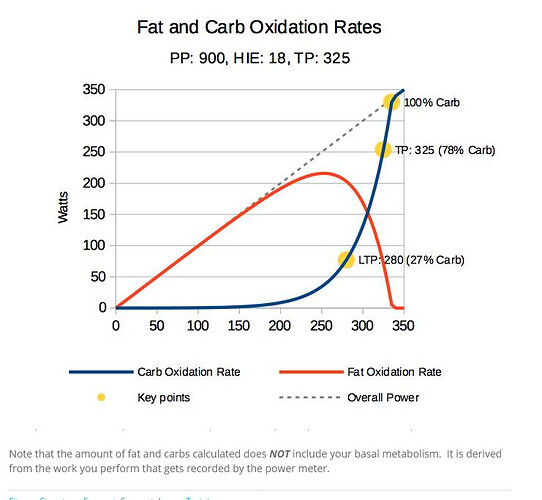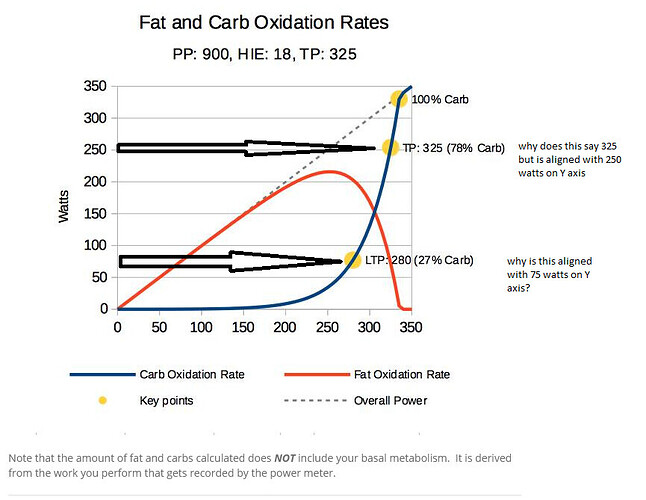Matches is the old way of looking at things pre MPA. It’s sort of obsolete because you don’t really have a number of matches. That’s just a simplification. What you have is capacity to perform above TP. That’s measured in kJ (kilojoules) i.e. work. The more kJ you have, the longer you can hold power above TP or the more matches you have. But the number and intensity of matches you have depends on intensity, amount of recovery and your fitness signature. These affect MPA and when MPA is low, you’re essentially out of matches and you have to wait until MPA recovers. If you wait long enough (and maintain good fueling), MPA will recover fully. Many athletes can reach Peak Power later in rides and can perform just as well as at the start if they managed their carb utilization and fueling. Those that don’t will see a degradation of the fitness signature and will not be able to perform the same as at the start. This is what we’ve called “Endurance Energy” and erodes fitness signature over time. That model isn’t represented in the current interation of Xert. Some would say that to have the impact of fueling modeled would be the holy grail of performance analysis.
Hi Armando, I am not trying to be difficult, and I am appreciative of your engagement on this topic and trying to educate me. I am still a bit lost. I know when I go above TP my MPA comes down and the rate is dependent on how much over the TP you are, say 200% eats up MPA really fast and 110% eats it up slowly. I know this is the secret sauce in WERT but there is a rate constant or some aspect of TP that defines that rate of decline. I don’t expect you to say what that is but I suspect that mathematically related to HIE? PP defines the beginning or max MPA you have, since that is also clear from the data on my fitness page. What troubles me is that I can go for a ride and be absolutely trashed when I get done but my MPA just blips off the top line. That is why I am trying to understand this. I need to get it into my head to understand how I can improve my ability to do that same ride without being trashed. What aspects of the signature is the key and how to get there. That is what I use XERT for not to race but to improve my enjoyment on tough rides or said another way how to make tough rides the same RPE just faster… or the same speed/ avg power just RPE is easier.
To understand this chart, the red line is the fat contribution to power and blue is carbohydrate. As power increases (along X-axis), more carbs contribute to the power. At LTP, 27% of the power comes from carbs (and 73% comes from Fat). The shape of those curves depend on your signature.
that part I got, the part that was ambiguous was where the TP and LTP yellow dots are relative to the Y axis values or are the yellow dot just the points for the LTP TP regardless of the watt value that aligns with them?..
I do not understand it myself but the values align on the x-axis.
Looking at it some more the y-axis seem to be fat and carbs values (those are the curves) and the x-axis is power output, so both curves added together.
I think you are right they meant to have the watts on the x axis and the Y was supposed to be nutrient usage in some arbitrary units.But,note the Y axis specifically says Watts, not g or any other measure of nutrient usage… so I still ask why the two are oddly aligned.
Both axis are Watts, one is the usage from carbs and fats separately (y) the other is both combined and thus the whole power output (TP and LTP marked). I think.
I think I got it now 
It reads like this: You look at the power output that you are interested in on the x-axis, say 150W and you see that you would use only fats then. At 200W there is a little bit of carbs contribution, at 300W both are about half of it (where the red and blue curves intersect) after that fat falls down fast and carb climbs fast and at about 340W everything comes from carbs.
yes that is right but the y axis is not watts it is grams (or mmols)/second (or minute) or some measure of rate of nutrient usage. So you are right the interpretation is easy if they had just put watts on the X axis and said rate of nutrient usage no units on the Y. The rate of carbs usage is zero then climbs as intensity climbs until fat drops to near zero at slightly over TP at which point carbs is a linear contributor and fat is zero. It makes perfect sense from a biochemical point of view, carbs take far fewer steps to turn into energy than fat so fat is a relatively slow burn whereas carbs is fast burn. If they pulled the graph out to the right there comes a point where the limited amount of carbs available starts to be limiting and that is another interesting point of this curve.
So I agree the understanding of the chart is simple once you ignore the units on the Y axis.
Now back to our normal question in this thread to understand how HIE factors into the overall aspect of rider performance. I did a workout I know can generate a breakthrough last night. I also know it will not change my PP so that means MPA is constant. The factors that were updated are TP /LTP and HIE. Both increased as I had expected. I am not any different from a rider point of view than 2 days ago… so with these adjustments to my signature how does that really impact my ride metrics. I am not a racer, I ride to enjoy and to keep up with the rest of the group who are often pushing my limits.
To enjoy the ride experience I need to improve my fitness, so I want longer duration at power above my TP and I want more long ride endurance. How does the change in HIE and TP relate to long ride endurance and ability to sustain power at 150 % of TP. The third aspect is also an endurance question, if the ride is punchy ie a lot of high and low power outputs how does that factor into over all fatigue. To me these are the questions I am trying to understand since the last one is one where it is rinse repeat cycles how many and how often and intensity all play a role in the over all effect and as Armando has said, energy utilization and fuelling in real time is the holy grail of exercise measurement/ performance prediction.
The graph is telling you that 75 Watts (27%) of Power is being produced from Carbs at LTP (280 Watts). The other 205 Watts (73%) is being produced from Fat.
The vertical axis could have been a percentage, but makes perfect sense as Watts.
Mike
yup that seems to be it, I think you are correct. Thanks
Do you actually want more time x% above TP (eg the 150% you mention), or just more time at a given power eg the power your fitter group riders are putting out? If you increase TP you’ll not need to go so far into the red to keep up, so you may only be holding 110% of TP or even riding at TP for those same absolute efforts
And presumably long ride endurance means ‘long ride at high power’ where again a higher TP (and LTP) would help? So overall you may be better off lowering HIE and increasing TP / LTP depending on objectives (noting there’s a trade-off). That’s where you’d look at focus and rider type?
You could use the workout builder to play with interactions to get a feel for it. Build a workout alternating between 400w and 200w efforts (or whatever interests you… something that is close to your group ride pace lines maybe) for whatever durations you’re interested in (eg 2 min on, 2 min off), then play with signature in that workout and see what’s required to make it do-able? You’ll see it’s not just higher HIE that improves ability to hold and recover from 400w efforts
Beyond the MPA Modelling, I think this one is about repeatability or fatigue resistance, linked to the holy grail Armando refers to, which is yet to be cracked by anyone? I guess higher training load and practice doing specific intervals will help with that though. And difficulty score helps give an idea of do-ability for shorter rides, even if the longer ride fatigue is not yet fully modeled…
Thanks for the reply, on the first question it can be a lot of things: ie lumpy course so need to go 150% of TP to get over the climb and stay with the group
it can be inconsiderate people who when they hit the front of the pace line pick the pace up 10%… if one is at or near TP then we are talking 110% of TP roughly
the endurance thing is slightly different,
in the upper case you are jumping then resting then jumping and resting over and over that is it seems a different sort of endurance (ie the ability to recover)
vs the latter which is just a high pace for a long time ie at, near or over TP… more just a relatively stable output but at a high effort for a long time… or a less than TP say LTP effort for a longer time…
So what I an trying to digest is the best way to understand my signature and how it relates to the different scenarios above. When your HIE is high what does that mean and what is actually a high HIE? Is there a relationship between HIE and TP that helps understand how they relate to the different types of efforts above?
As far as I can tell PP is only a means of determining you MPA ceiling, ie it is your maximum power output and thus MPA must decline from that number. However the rate of that decline appears to be a factor of the amount you exceed your TP. Also when MPA falls below your TP you have theoretically exhausted your power reserve if your signature is correct, you should bi e in a state of failure at that point and must start to recover.
I sort of maybe get the principles of XERT and as Armando said above HIE is kJ and “The more kJ you have, the longer you can hold power above TP” but nothing seems to tell me the rate I burn up hose kJ and I guess that may just be the way it has to be until we reach the holy grail. My physiology seems to be better at short repeated efforts then long hard efforts. I can definitely get a breakthrough with repeated short hard efforts with short (about 30 sec) rest intervals say 3 hard (150% TP) then one really hard (say start at 200% TP and hold as long as you can) and I can almost guarantee a breakthrough will happen. But try to hold 125% of TP and I can not get MPA to decline before I am unable to continue…so that is the equation I am trying to crack.
“[4000 words] …so that is the equation I am trying to crack.”
You’re trying too hard. Go ride! 
When one is trying to gain understanding there is no such thing as trying too hard! But I do still have a good time riding my bike regardless if I understand XERT or not! <40 words;-)
On this one, if Xert’s modeled power doesn’t closely align with what you can do (when fresh, motivated etc) it is possible that your signature is not dialed, and it maybe worth getting support to take a look. The algorithms are not always perfect (and / or maybe they’d say the data going in is not always perfect ![]() )
)
On a related note, I recall @GoustiFruit had issues holding 95% of TP for 4x8 minutes per previous forum posts (see front load periodisation ones), despite being able to have a BT on Ronnestad style efforts. Not sure if that was ever clarified but sounds similar to what you are seeing.
I’m pretty sure that there is something wrong with Xert’s algorithms or model to generate the signature: I’ve been doing lots of HIT workouts during the Winter, with very low volume; so, yeah I was able to finish workouts with short and intense intervals, but I lost A LOT on the side of the endurance, so it was a real pain to hold power around threshold for more than a handful of minutes ! I guess that it’s very inaccurate to evaluate a TP solely based on the ability to do short intervals. Being able to push some watts for a short duration, doesn’t relate to the power that you are able to sustain for long periods.
It’s like comparing bodybuilders to endurance cyclists: sure, bodybuilders can push a lot of watts… on explosive efforts. But they wouldn’t be able to follow the average cyclist on his Sunday easy ride.
Reminds me of some of VC’s videos ![]()
So, I don’t know how the HIE relates to this. I think that there must be at least a fourth variable to make the model more credible. It should take in consideration the volume that you accumulated through your training period.
At least, my training this Winter made me realize that, yeah, volume is a primordial parameter for someone who wants to improve his TP. HIT won’t help you on long intervals, it will only improve the explosiveness, and maybe the repeatability of short efforts. But if you can’t hold a good percentage of your threshold power for a long time, your HIE is mostly useless.
My conclusion: I’m going back to the work on longer rides, starting with focus around LTP, then some TP intervals, and I will try to keep doing some HIT sessions here and there to maintain the (relative) power I got this Winter on shorter intervals…
Gousti, I agree with you totally. In fact I have been looking at W prime to see if I can get a clue… I know Armando will say they are different and that may be so but the research in this area has found that the rate of use is fairly universal (at least that is how I interpret the papers) but the replenishment is very individual. The have introduced a replenishment factor called Tau W. This is a personal variable. Skiba et al and others have done work on this. He has examples where the replenishment rate would suggest at certain wattage relatively impacts the time to replenish. (Understanding Work Above Threshold) and the rate is quite different from XERT’s. " It turns out that the relationship is defined by the difference between CP and the recovery power. Thus, a person with a CP of 300W will recover more quickly when they drop to 20W than a person with a CP of 200W. In the former case, the person is recovering 280W below CP. In the latter case, the person is recovering only 180W below CP. This helps explain why great athletes seem to recover so quickly." so that might be a clue? Personally I have always been good at short hard effort, but do not have super high PP. Currently like you I have poor long duration power endurance and that is what I am trying to focus attention on to improve. (lots of words this time  )
)
That is what I exactly try to do @GoustiFruit ! Endurance, Climber, then some HIT once in a while.
And I have the exact opposite issue regarding breakthrough! I have lots of difficulty achieving breakthrough using high intensity (intervals), but no issue at all doing it on FTP test. I find FTP test much easier to do than high intensity.
Eventually, we’ll reach in the middle…



